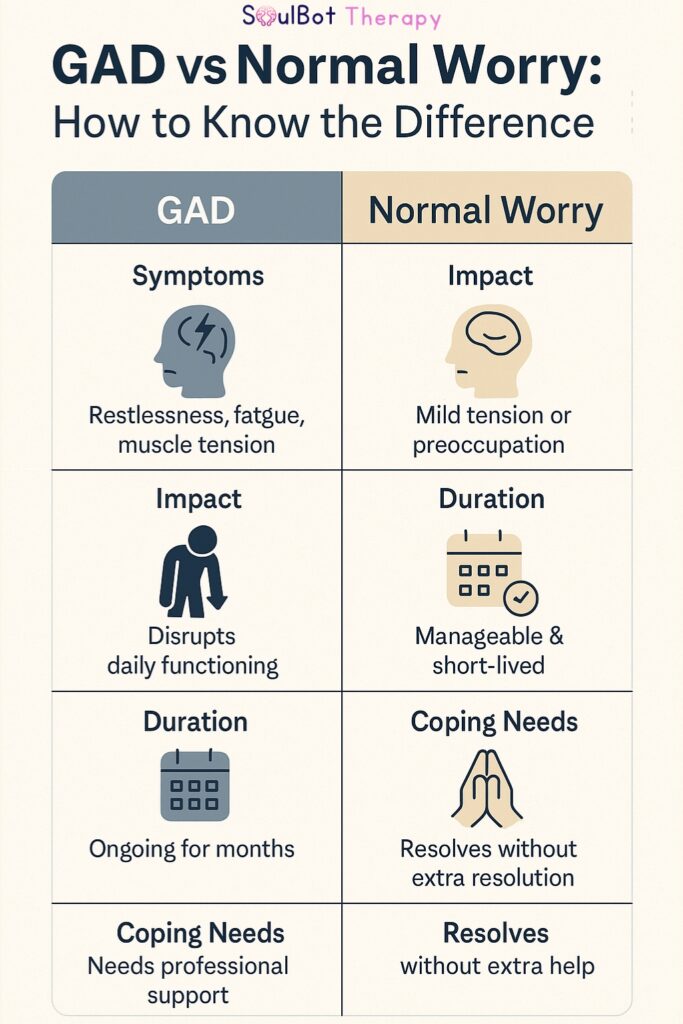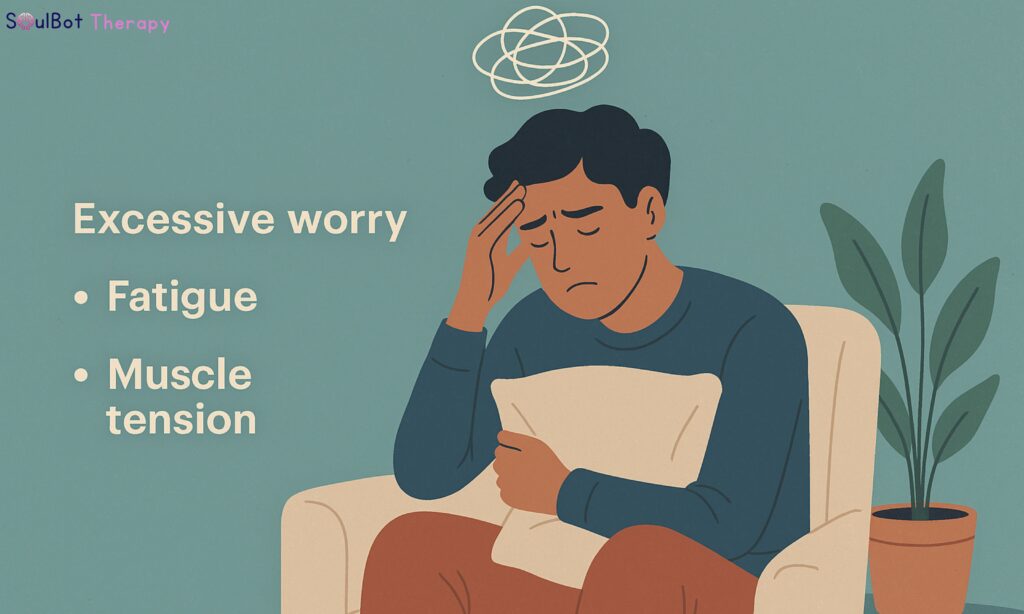“Why do I feel constantly on edge even when nothing’s wrong?”
If your brain feels like it’s always spinning worst-case scenarios, and you can’t seem to switch it off, it might be more than everyday stress; it could be Generalized Anxiety Disorder (GAD).
In this blog, we’ll break down the signs, causes, coping tools, and how AI-powered mental health support like SoulBot Therapy can help you manage anxiety with less shame and more control.
🧠 What Is Generalized Anxiety Disorder (GAD)?
GAD is a chronic mental health condition where a person experiences excessive, persistent worry about everyday situations, often without any clear trigger.
It affects:
- How you think
- How your body reacts
- How you sleep, focus, and interact with others
🧾 Fact: According to the Anxiety & Depression WHO, GAD affects nearly 6.8 million adults, yet only 43% are receiving treatment.
🧩 Symptoms of GAD (It’s More Than Worry)
You may have GAD if you experience:
- Constant worry that’s hard to control
- Restlessness or feeling “on edge”
- Muscle tension and body aches
- Trouble sleeping or staying asleep
- Trouble concentrating (mind goes blank)
- Feeling fatigued, drained, or irritable
💡 These symptoms last for 6+ months and interfere with your daily life.
🔍 What Causes Generalized Anxiety Disorder?
There’s no single cause, but common triggers include:
🔬 1. Genetics & Brain Chemistry
People with GAD often have imbalanced brain chemicals like serotonin and dopamine.
🧠 2. Personality Traits
You might be more prone if you’re highly perfectionistic, self-critical, or a people pleaser.
🧸 3. Childhood Experiences or Trauma
Growing up with unpredictable caregivers, criticism, or emotional neglect can train your brain to “expect the worst.”
🌪️ 4. Lifestyle Stressors
Burnout, health concerns, and money worries — all can activate GAD symptoms, especially if unmanaged.
🔁 GAD vs Everyday Anxiety
| Feature | GAD | Everyday Anxiety |
| Duration | 6 months or more | Temporary |
| Triggers | Often unclear or general | Usually clear and situational |
| Body impact | Muscle tension, fatigue, and sleep | Mild restlessness or nervousness |
| Interference | Affects daily life significantly | Doesn’t impair normal functioning |
🛠️ How to Cope With GAD (Real Tools That Work)?
💬 1. Name the Thought
Instead of spiraling, try:
“That’s an anxious thought, not a fact.”
📚 2. Use Cognitive Reframing
Ask: “What’s the most realistic outcome here?”
🧘 3. Regulate Your Body
Practice deep breathing (4-7-8 method), light movement, or cold water splash when anxiety spikes.
📓 4. Track Anxiety Triggers
Use a journal or SoulBot’s AI-powered mood tracker to spot patterns.
📞 5. Seek Therapy or AI Support
Professional help (AI-powered mental health support) can teach grounding techniques, thought restructuring, and nervous system regulation.
💡 Introducing SoulBot Therapy – Your AI Mental Health Coach
SoulBot is India’s intelligent AI Mental Health Companion designed to:
- Understand your anxiety levels with self-assessments
- Respond to your emotions in real-time.
- Recommend calming techniques based on your triggers.
- Connect you to certified therapists for free consultations.
✅ It’s like a therapist in your pocket, always listening, never judging.

🎯 Final Thoughts: GAD Isn’t Your Fault, But Managing Is Your Power
Living with constant worry doesn’t mean you’re broken.
It means your brain tries to protect you even when there’s no danger.
The goal isn’t to eliminate anxiety, but to understand it, manage it, and not let it control your life.
🧠 Ready to understand your anxiety better?
✨ Take the Anxiety Self-Assessment now and meet SoulBot, your always-on support system.








